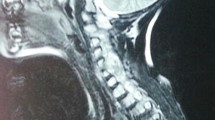Summary.
The primitive neuroectodermal tumor is a rare soft tissue neoplasm occurring in children and young adults. It derives from a carcinogeneic alteration of pluripotent neural crest cells, caused by a balanced reciprocal translocation t(11;22) (q24;q12). Treatment of this undifferentiated, extremely malignant small cell tumor is carried out in compliance with the soft tissue trail (CWS) from the German Society of Pediatric Oncology. Biopsy-proven diagnosis is followed by primary chemotherapy, which in 95 % of cases leads to remission, allowing excision of the remainder of the tumor without mutilation and avoidance of intraoperative tumor cell dissemination. After excision, irradiation of the tumor site and two further sequences of chemotherapy are performed. If PNETs of the paravertebral region cause symptoms of paralysis and immediate surgery is required, postoperative chemotherapy, a second-look operation and irradiation are mandatory. Between 1986 and 1994, in cooperation with our pediatric and radiotherapy colleagues, we treated ten patients. In four patients (median age, 14 years) the PNET originated from the chest wall, in six patients from the paravertebral and retroperitoneal region. Five patients died after 20 months on average, while the remaining five patients are in full remission after 31, 46, 50, 51 and 91 months, respectively.
Zusammenfassung.
Der periphere primitive neuroektodermale Tumor (PNET) ist ein sehr seltener hochmaligner Weichteiltumor bei Kindern und jungen Erwachsenen. Er resultiert aus einer balanzierten reziproken Translokation an den q-Armen der Chromosomen 11 und 22, die zur malignen Entartung pluripotenter Zellen der Neuralleiste während der Embryogenese führt. Die Behandlung dieses undifferenzierten, kleinzelligen Tumors erfolgt gemäß der Kooperativen Weichteilsarkomstudie (CWS) der Deutschen Gesellschaft für Pädiatrische Onkologie: Durch eine präoperative Chemotherapie mit einem EVAIA-Schema gelingt in 95 % der Fälle eine Remission, wodurch ein verstümmelnder Eingriff vermieden und das Risiko einer intraoperativen Tumorzellaussaat verringert wird; nach Resektion des Resttumors sind eine Nachbestrahlung des Tumorbetts sowie weitere Chemotherapiezyklen vorgesehen. Ist wegen eines Querschnittsyndroms beim paravertebral gelegenem PNET eine primäre Operation erforderlich, ist unmittelbar postoperativ eine Chemotherapie, gefolgt von einer „Second-look-Operation“ und Nachbestrahlung obligat. Gemeinsam mit unseren Pädiatern und Strahlentherapeuten behandelten wir zwischen 1986 und 1994 10 Patienten. Bei 4 der zwischen 4 und 26 Jahre alten Patienten (Median: 14 Jahre) nahm der PNET seinen Ursprung von der Thoraxwand, bei 6 Patienten war er paravertebral-retroperitoneal lokalisiert. Fünf Patienten verstarben nach durchschnittlich 20 Monaten, 5 Patienten befinden sich nach 31, 46, 50, 51 und 91 Monaten in Vollremission.
Similar content being viewed by others
Author information
Authors and Affiliations
Rights and permissions
About this article
Cite this article
Zimmermann, T., Blütters-Sawatzki, R., Berghäuser, KH. et al. Der primitive neuroektodermale Tumor. Chirurg 68, 732–737 (1997). https://doi.org/10.1007/s001040050262
Issue Date:
DOI: https://doi.org/10.1007/s001040050262




